
We’ve occasionally touched upon the choice that today’s youth make in choosing a career or path. Enough of our peers are already in, or heading towards medicine, and no encouragement is needed in that direction. But good news- now you pre- med students have more options in the U.S.!
med students have more options in the U.S.!
There has long been an imbalance in the demand for seats in medical schools, and the supply of seats available. Bright students have had to travel internationally to study, sometimes learning to study without reliable electricity. However, during the 80s and 90s, only one new medical school was established. This is finally changing. Nearly two dozen medical schools are opening, or might open in the near future. [NYT]
The proliferation of new schools is also a market response to a rare convergence of forces: a growing population; the aging of the health-conscious baby-boom generation; the impending retirement of, by some counts, as many as a third of current doctors; and the expectation that, the present political climate notwithstanding, changes in health care policy will eventually bring a tide of newly insured patients into the American health care system. [NYT]
The interesting aspect of this growth is that many of the creators of these new programs aim to create doctors different from today’s. They claim they will produce doctors who aim to serve immigrant and underserved communities.
Many of the developing medical schools are well aware of such arguments, and are billing themselves as different from traditional medical schools, more focused on serving primary care needs in immigrant and disadvantaged communities. Administrators say that they expect that approach to be buttressed by a shift in state and federal reimbursements from specialists to primary care doctors. [NYT]
In any case, they’ll be closer to home!
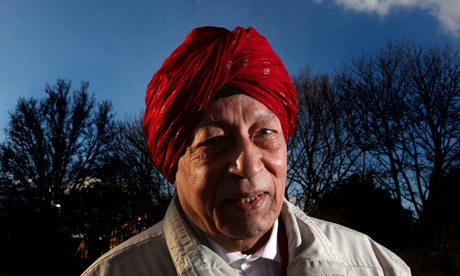 In some way I know I shouldn’t even be writing this. I am giving an idiot the fame that he seeks, but doesn’t deserve. Oh well, here we go.
In some way I know I shouldn’t even be writing this. I am giving an idiot the fame that he seeks, but doesn’t deserve. Oh well, here we go.
So Rajinder Singh is an idiot. Rajinder Singh wants to be the first non-white to join the British National Party (BNP) in the UK. To those from elsewhere, the BNP is similar to the KKK, without the sheets and ropes. For years they had limited (if that’s the right word) their membership to people of “Caucasian origin.” The Equality and Human Rights Commission had threatened them with a court injunction if they did not open up their ranks.
Playing on the issue of anti-immigration and Muslimophobia, the fast blinkers (read conservatives) are making some noise in the wake of the economic downturn. However, due to a court ruling and a willing lackey, it seems the BNP is about to gain Rajinder.
For the cameras, Rajinder has decided to label himself a Sikh and wear a turban.
Singh – admits he’s only wearing it for my ¬ benefit. He’s not a religious man and is clean shaven, but he wore a turban the first time he ever had “media exposure” – on BNPTV, the party’s online ¬channel – and has decided to do so whenever speaking to the media because “the message carries more weight” coming from a turban-wearing Sikh.[link]
My question – does wearing a turban give him more ‘weight’ amongst Sikhs or non-Sikhs?
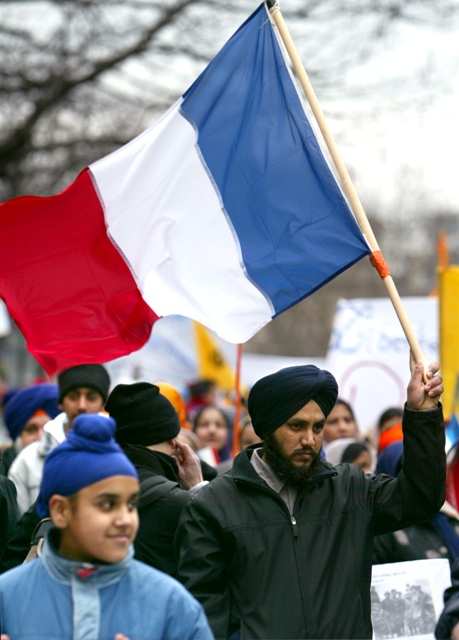 French legislators are currently considering a ban that would prevent Muslim women the right to wear full-body veils in public areas such as buses, trains, hospitals, restaurants, schools and other public places. Since 2004, head scarves and other signs of religious affiliation have been banned from public schools by a government determined to enforce France’s tradition of strict secularism amid fears of growing fundamentalism. Although Sikhs have also been fighting for their right to wear turbans in France – what will an overt ban, which sends a clear statement to its citizens about religious tolerance, mean to other minority groups in the country?
French legislators are currently considering a ban that would prevent Muslim women the right to wear full-body veils in public areas such as buses, trains, hospitals, restaurants, schools and other public places. Since 2004, head scarves and other signs of religious affiliation have been banned from public schools by a government determined to enforce France’s tradition of strict secularism amid fears of growing fundamentalism. Although Sikhs have also been fighting for their right to wear turbans in France – what will an overt ban, which sends a clear statement to its citizens about religious tolerance, mean to other minority groups in the country?
Identifying the burqa as alien to French culture, say the ban’s critics, also fans xenophobic sentiment. What will be declared un-French next? The sari? The Sikh turban? Day-Glo bicycle shorts? [link]
Interestingly – there are only about 2,000 Muslim women in France who wear these veils. Many say that France, a country that prides itself on liberal democracy, is simply taking away the individual freedom to make a choice. As an Op-Ed piece in the NYT asks, “Why the French obsession with the burqa? After all, as the French government itself has conceded, only about 1,900 women wear the full-body covering. So why are over half of the respondents in recent public opinion polls in favor of a ban on it?”
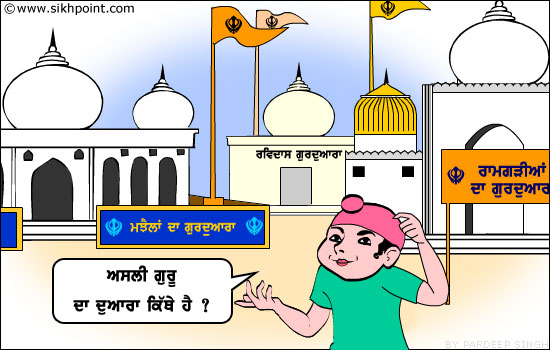 There has been much in the news in Sikhdom with repercussions for years to come. The news of Professor Darshan Singh Ragi, former head of the Akal Takht, and even the Nanakshahi deserve time and commentary. I will leave those for another day.
There has been much in the news in Sikhdom with repercussions for years to come. The news of Professor Darshan Singh Ragi, former head of the Akal Takht, and even the Nanakshahi deserve time and commentary. I will leave those for another day.
In some ways with even greater repercussions has been the announcement by members of Dera Sach Khand Ballan of the removal of the Guru Granth Sahib from their places of worship. It is key to point out that NOT all people that identify themselves as Ravidasia are part of Dera Sach Khand Ballan and many vehemently oppose some of their policies and tenants. Still their following is significant and important. Talk of the removal of the Guru Granth Sahib had been in the works since the unfortunate events in Vienna last year. Even at that time, I had asked the question, “How large is the tent that is the Sikh Qaum”?
I commended the Singh Sabha for their achievements in their time and place:
Despite the various attacks on the Singh Sabha movement for only promoting Khalsa hegemony and other spurious slanders by neo-Sanatans, post-colonialists attempting to form neo-Brahman ‘intelligentsias’, those that believe they ‘own’ the Sikh identity, some Hindu chauvinist groups, and various beatniks, the movement was in fact very broad-minded and fought to enlarge the tent that is the Sikh Qaum.
They understood the difference between public and private aspects. In private, people may have their own practices, beliefs, etc. and while the Singh Sabha sought to bring these more in line with the practices and principles of Gurbani, they did allow some diversity in private. In public, we come together and stand by the Panthic rehat maryada.[link]
The Dera Sach Khand Ballan has now made the political move to ‘declare’ a new religion and call for the removal of the Guru Granth Sahib. It is important to NOTE that the move is being pushed by a section of the Ravidassia community and has found much opposition as well.
Two years ago, a group of friends started this blog to create a platform where we could discuss issues concerning the  Sikh community, in a reflective, self-critical, and progressive way. We envisioned it as a way to continue the conversations that happen in many Sikh conferences around the U.S., between the sporadic and short times that we are able to meet face-to-face.
Sikh community, in a reflective, self-critical, and progressive way. We envisioned it as a way to continue the conversations that happen in many Sikh conferences around the U.S., between the sporadic and short times that we are able to meet face-to-face.
We wanted to create a safe space for conversations that we felt were critical, but didn’t see happening as much as they were needed.
Since that beginning, our readership has grown, our vision has grown, and now, so too must our capacity.
We are looking for passionate Sikhs who share our dedication to our community and faith, to join in contributing to the broad array of conversations that take place on The Langar Hall’s pages. Do you enjoy writing? Are you interested in engaging in conversation with other Sikhs from throughout the world? If so, send an email to admin@thelangarhall.com and let us know you’re interested.
We don’t always talk about Sikh issues, but instead, share the common thread of being Sikh. Our Sikh heritage shapes our worldview. Our interests and perspectives, however, are as varied as any group of individuals. Whether you’re interested in art, music, literature, politics, movies, or social activism, if you’re rooted in Sikhi, and have an inclination to write, we want to hear from you.
We’d love to have contributors that are as global as our diaspora. In the past, most of our bloggers have been from North America. However, we post about events that happen all over the world. We want to hear from you whether you’re in Australia, Kenya, India, the U.S., or anywhere else in the world. No matter where you are, if you’re interested in blogging for The Langar Hall, let us know! Email admin@thelangarhall.com.
Over the past few months, we have come across various articles in the media depicting the state of affairs for students of Indian origin living in Australia. Attacks against Indians (allegedly racially motivated) and, what was perceived to be, a poor response by the police and leaders sparked protests in both Australia and India. Widespread media coverage in India has been especially critical of Australia’s handling of this violence. On the other hand, however, the Indian media’s coverage has been likened to hysteria by many in Australia. Many are saying that the Indian media has done more harm than good in their coverage of the events, and in doing so, have shadowed the real problems faced by students in Australia.
So what exactly is going on? A few days ago we received an email from a TLH reader in Australia who wanted to share his perspective on the situation:
I am a year 12 student from Australia about to go into university and I would just like to express some opnions which I hope you could take to the readers of The Langer Hall. Recently there has been much uproar in the Indian media and community about these so-called racist attacks on Indian students in Australia. It really pained me to hear how such events could occur in what has developed to be one of the most multicultural countries in the world. Having just finished school I can say that the range of cultures and backgrounds which I have been exposed to…has been awesome. In my fifteen years as a turbaned boy I have not once felt like this country holds any form of racist ideas against me. My father has been a turbaned bus driver, and now a train driver for many years and he expresses similar ideas to me… Just recently the news begins to appear through investigations by Australian Police that many of these attacks on Indian students..were in fact carried out by other Indian students. I am not saying that all the attacks that occur…are by Indians…but i am raising the point that Australia is not as bad as many people make it seem. I see in Indian newspapers everyday that there was some attack on an Indian and they request Indians to stop going to Australia. Yet not one paper made mention of the fact that it was Indian students who had been arrested for the murders. Well I suppose that is expected in India… [-KS]

The Multifaith Calendar is looking for art submissions under the theme “Celebrating Diversity”. They would like to feature art from as many different faith groups as possible. This calendar is a great educational tool that lists and explains holidays that are important to 14 different world faiths including Sikhism.
The theme for the 2011 edition is: Celebrating Diversity. Work can be of any medium. The interpretation of the theme will be determined by the collection, so we invite artists to submit images that capture a unique or poignant expression of art or people celebrating their faith. We are looking to showcase a diversity of faiths in the collection. We encourage all artists to submit images, including artists who have had their work showcased in past Multifaith Calendars. [link]
Sounds like a great project and a wonderful opportunity for the many developing artists in our community. Submissions are due by February 28th, 2010. For more information, please see: www.multifaithcalendar.org
Religions derive their power and popularity in part from the ethical compass they offer. So why do so many faiths help perpetuate something that most of us regard as profoundly unethical: the oppression of women? [NYT]
An op-ed piece in the NYT, by the notable Nicholas Kristof, looks at the way many religions perpetuate and sanctify the oppression of women. He discusses that many abuses, such as mass rapes, arise out of a social context in which women are considered second-class citizens and argues that this social context is something religions have helped shape rather than fought hard to change. Kristof wrote this op-ed after listening to former President Jimmy Carter’s speech to the Parliament of the World’s Religions in Australia last month.
Mr. Carter, who sees religion as one of the “basic causes of the violation of women’s rights,” is a member of The Elders, a small council of retired leaders brought together by Nelson Mandela. The Elders are focusing on the role of religion in oppressing women, and they have issued a joint statement calling on religious leaders to “change all discriminatory practices within their own religions and traditions.”
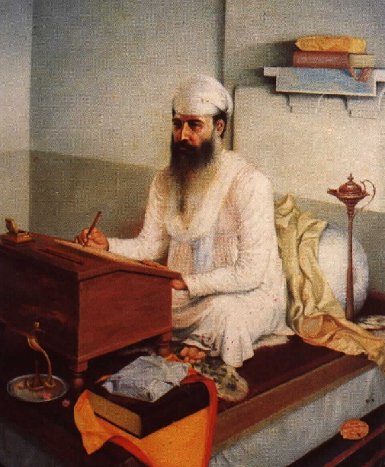 Months ago we announced the first Sikh graduate student conference – SIKHOLARS, being hosted by the Jakara Movement and Sikh Spirit Foundation.
Months ago we announced the first Sikh graduate student conference – SIKHOLARS, being hosted by the Jakara Movement and Sikh Spirit Foundation.
Today, the confirmed participants have been announced:
- Ajeet Singh Matharu, Columbia University, History, N/A
- Arvinder Singh Kang and Amanpreet Singh Brar, University of Mississippi, Computer Science, Extending Gurmukhi Script into Twenty-first Century & Beyond
- Bandana Kaur, Yale University, Environmental Management, Reclaiming Natural Histories: Biodiversity and Landscape in Pre-Green Revolution Punjab
- Erik Resly, Harvard Divinity School, Divinity, (Re)figuring the Sikh: Theodicy, Discipleship and Narrative in Ethical Perspective
- Harjant Gill, American University, Anthroplogy, From Putt Jattan De to Munde UK De: The Transformation of Masculinities in Punjabi Cinema
- Iqbal Kaur Gill, University of British Columbia, Counseling Psychology, First Generation Canadian Punjabi Sikh Parents Beliefs about Adolescent Suicide and Suicide Related Behaviours
- Kamal Arora, York University, Social Anthropology, The Politics of Pain: Gender, Mourning and the Punjab Crisis
- Mandeep Kaur, University of Texas (Austin), Nursing, The Sikh Patient: A Review of the Nursing Literature
- Mette Bach, University of British Columbia, Creative Writing, The Changing Faces of Suburbia
- Preet Kaur Virdi, York University, Socio-Legal Studies, Silence: Resistance or Acquiescence? Sikh women’s perspectives on Canadian law
A thorougly diverse and intriguing display of scholars. We eagerly await for the conference. We hope others can attend February 20, 2010 at Stanford University.
For more information and to read the abstracts, see here.
- Ajeet Singh Matharu, Columbia University, History, N/A
- Arvinder Singh Kang and Amanpreet Singh Brar, University of Mississippi, Computer Science, Extending Gurmukhi Script into Twenty-first Century & Beyond
- Bandana Kaur, Yale University, Environmental Management, Reclaiming Natural Histories: Biodiversity and Landscape in Pre-Green Revolution Punjab
- Erik Resly, Harvard Divinity School, Divinity, (Re)figuring the Sikh: Theodicy, Discipleship and Narrative in Ethical Perspective
- Harjant Gill, American University, Anthroplogy, From Putt Jattan De to Munde UK De: The Transformation of Masculinities in Punjabi Cinema
- Iqbal Kaur Gill, University of British Columbia, Counseling Psychology, First Generation Canadian Punjabi Sikh Parents Beliefs about Adolescent Suicide and Suicide Related Behaviours
- Kamal Arora, York University, Social Anthropology, The Politics of Pain: Gender, Mourning and the Punjab Crisis
- Mandeep Kaur, University of Texas (Austin), Nursing, The Sikh Patient: A Review of the Nursing Literature
- Mette Bach, University of British Columbia, Creative Writing, The Changing Faces of Suburbia
- Preet Kaur Virdi, York University, Socio-Legal Studies, Silence: Resistance or Acquiescence? Sikh women’s perspectives on Canadian law
Today, January 5th, Sikhs around the globe will come together to celebrate Guru Gobind Singh Ji’s gurpurab. On this day we celebrate our Guru and the gift that was bestowed upon us. Guru Ji’s famous quote tells us that living as a Sikh is as much important as appearing as a Sikh and that with both, hand in hand, we are a Sikh of the Guru.
![]()
The shabad below, Nasro Mansoor, was written in persian by Bhai Nand Lal Singh. It’s beautiful! Gurpurab greetings to all!
A few weeks ago, Maple Leaf Sikh said that “We often lament the state of our gurdwaras but we should just as often stop and think about how much we have accomplished.” How very true! How often do we highlight communities where things are working well for the Sikh diaspora? 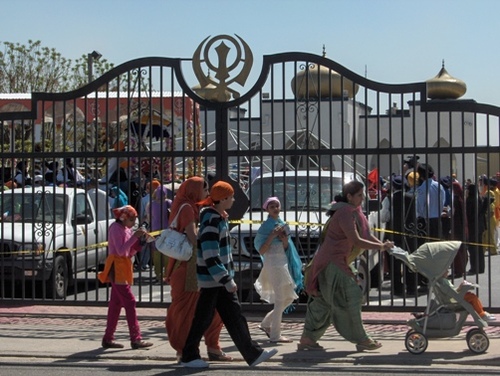 A recent article tells us how a small town in Central California, Livingston, is helping to bridge a gap created by a cultural, linguistic and religious divide between generations. Recognizing that language is the link to religion for Sikhs, the sangat in Livingston has ensured that children in the area have the opportunity to attend Punjabi classes and learn the language.
A recent article tells us how a small town in Central California, Livingston, is helping to bridge a gap created by a cultural, linguistic and religious divide between generations. Recognizing that language is the link to religion for Sikhs, the sangat in Livingston has ensured that children in the area have the opportunity to attend Punjabi classes and learn the language.
There’s a lasting link between the 35-character alphabet used to write Punjabi and the Sikh religion. The Sikh scriptures and the Punjabi language of many Sikhs were written in a script known as Gurmukhi. So to be fully initiated into the religion, you must know how to read it… Tripat Grewal, who helps teach Punjabi language classes, said that for many Sikhs the fact that their children couldn’t understand what was being said in the temple was at the heart of the effort to create Punjabi-language classes. “The religious part was very important,” she said. [link]
When the space at the local Gurdwara became too cramped, the leaders secured classroom space at a local elementary school. While these efforts aren’t the first of its kind, it’s always great to hear a community coming together to address a need. For those of us who are familiar with the small towns scattered across central california — these punjabi classes are vital to bridging the divide between generations. With large immigrant populations and many living in joint families – being able to communicate effectively with one another is and will continue to be an important part of the diaspora.
A few months ago, RP Singh wrote a very timely post on compassion and what it means to Sikhs. In Gurbani, the word Daya often translates to compassion, a trait which is long known in our history. One of the Panj Pyara or beloved five was Bhai Daya Singh and thus, Compassion along with Justice, Courage, Discipline and Leadership are important elements of the Khalsa.
As a reminder of this and as we get ready to begin a New Year – I wanted to share with you the Charter for Compassion – “a call to bring the world together.” It is stated that, The principle of compassion lies at the heart of all religious, ethical and spiritual traditions, calling us always to treat all others as we wish to be treated ourselves. Compassion impels us to work tirelessly to alleviate the suffering of our fellow creatures, to dethrone ourselves from the centre of our world and put another there, and to honour the inviolable sanctity of every single human being, treating everybody, without exception, with absolute justice, equity and respect. [link]
I would encourage you to watch the video below and sign the charter. It might be a passive form of activism, however, let it be a nudge to hold ourselves accountable in the coming years – to live compassionately and emulate Sikhi in one of it’s purest forms.
 The events following the June elections in Iran continue to reverberate. The allegations of widespread election fraud led to hundreds of thousands of Iranian youth to take to the streets and asking “Where’s My Vote?”
The events following the June elections in Iran continue to reverberate. The allegations of widespread election fraud led to hundreds of thousands of Iranian youth to take to the streets and asking “Where’s My Vote?”
A regime unable to answer its citizenry and an escalating use of repressive tactics has led many to begin questioning the legitimacy of the government. Born out of a revolution in 1979, a generation has grown up on legitimizing the current regime through understanding of the tyranny of the Shah’s. However, the tactics unleashed in the wake of the elections has shifted the public from asking about votes to calling for the ouster of the Supreme Leader. Khamenei has none other to blame than himself through his partisanship in siding with Ahmadinejad, rather than standing above the fray.
A few weeks back, while skimming through the news, I found an interesting report on Canadian Prime Minister 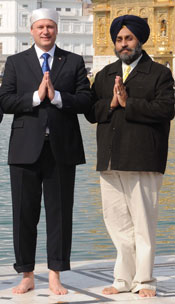 Stephen Harper’s recent visit to the Darbar Sahib in Amritsar. Although I didn’t care much for the hoopla around his visit, I did find it interesting that he “offended” Sikhs by refusing to accept parshad or langar.
Stephen Harper’s recent visit to the Darbar Sahib in Amritsar. Although I didn’t care much for the hoopla around his visit, I did find it interesting that he “offended” Sikhs by refusing to accept parshad or langar.
As I understand it, the preparation of parshad (grace) is unique in that it is ceremonially touched by a kirpan (kirpan bhet), which serves as an indication of the Guru’s acceptance and blessing. It is then distributed to 5 Amritdhari Sikhs representing the Guru Khalsa Panth. A Sikhs’ consumption of parshad displays a submission to the Guru. So accepting parshad is essentially “accepting His grace.” I’ve also been taught that parshad should be distributed after the hukamnama is read, as accepting parshad symbolizes acceptance of the hukamnama.
Now, whether or not Sikhs themselves understand the hukamnama, or even listen to it is another post for another day – but, if accepting parshad is accepting the Guru’s hukam, should a non-believer accept it? Although the Rehat Maryada states that parshad should be offered to everyone equally (as it should), should we be offended if someone rejects it? If a non-Sikh understands the meaning behind our practice and politely refuses it out of respect, shouldn’t we appreciate it instead?
I remember years ago at a Sikh Day Parade in Washington DC, as a handful of us were walking through the sidewalks handing out “Who are the Sikhs” pamphlets and answering questions from onlookers, an elderly BibiJi was darting through the crowd distributing parshad to random strangers. As shocked as I was to see this, it couldn’t compare to the shock on the face of those who received it. Most were not sure what to do with it, or joked about it with their friends, while others were seen throwing it away. I’m sure the BibiJi’s heart was in the right place, but what were we hoping to accomplish by this?
My question is…how can we value our traditions if we don’t even understand them?
And if we don’t value our traditions, how can we expect others to?
Continue Reading »
In predominantly Christian countries like the U.S., Christmas has become a cultural holiday that even non-Christians celebrate to some extent. Most of us enjoy, at least, taking advantage of days off, eating lots of cakes and pies, and spending time with family and friends.
The Times of India thinks Christmas can do even more than give us a day off work… like heal the wounds caused by police brutality in Ludhiana against Sikh protesters of Ashutosh and the Divya Jyoti Jagriti Sansthan. Of course, TOI also mischaracterizes the conflict at issue as one between migrants who now feel left out of Ludhiana’s social fabric and Sikhs.
Christian organizations are planning to celebrate the festival by reaching out to the migrants, who have been feeling left out after the riots they were involved in and to Sikh protesters, who got hurt in police action.
“Christmas celebrations have the twin themes of peace and prosperity. We will be going to the areas like Dhandari, which have many migrants staying there and witnessed a lot of clashes during the riots,” said Albert Dua, president of Christian United Federation. [TOI]
TOI journalists may not have much of a grip on reality, and are probably overestimating what one holiday and a few days off can do. Still, I do hope you enjoy the holidays, however you spend them. Happy holidays!
On a remotely related note, if Santa were Punjabi….

A charity based in Southall, called the Drug and Alcohol Action Programme (DAAP) will be joining forces with local Gurdwaras to address high rates of alcohol abuse taking place at Asian, particularly Punjabi Sikh, weddings. Perminder Dhillon, CEO of the charity states that “it is no longer acceptable to ignore the dangerous levels of alcohol drinking at these events.”
There is a mistaken view in Asian communities that religious and cultural backgrounds act as a barrier to the kind of drunken scenes so often seen in so many town centres all over the country. She said: “Many parents feel pressurized to provide a huge quantity of alcohol at weddings even if they themselves are non-drinkers”. [link]
She goes onto say that there are huge expectations on families to provide alcohol at weddings – often demanded by the groom’s side. This problem has become so extensive now that it is likened to demanding dowry and by partaking, “we end up supporting users with alcohol-related health problems during the binge-drinking period”.
Research published in the British Medical Journal suggests that men of South Asian origin in Britain are four times more likely to die of alcohol-related liver problems than other ethnic groups. Eighty percent of those South Asians who are vulnerable to alcohol-related mortality are Sikhs.
The charity has stated that the strategy they will use to combat this issue is simple – they will “name and shame” those involved and publicly condemn individuals on their website.
A few weeks ago we posted about the issue of women in Punjab marrying men from outside of Punjab, to only be deserted by them after marriage. The post created a colorful (although often one-sided) dialogue about the issue. While our response in the diaspora is significant and can often help initiate conversations and perhaps also change, it is the commentary by the community in Punjab which is hugely important. The video below is one such response to the issue of seeking grooms from outside of Punjab. Is the value placed on sending young Punjabi women to the UK, US and Canada higher than ensuring their happiness?
Original post can be seen here.
News continues to filter in and the dust settles. While the violence of yesterday has passed the ramifications are still to be seen.
The death toll continues to climb and on Sunday the Punjab Police called curfew throughout Ludhiana.
Today (Monday) a bandh is being called on by various Sikh organizations.
Below is a newscast describing the incidents and the police charge without warning. Reminds one of General Dyer in Amritsar 1919.

Recent coverage on The Langar Hall led us to celebrate the victory in Surrey of the YOUTH SLATE. Now here in the United States we have the formation of the SIKH SLATE.
8 Sikh organizations (Ensaaf, the Jakara Movement, SALDEF, Sikhcess, Sikh Research Institute, Surat Sikh Conference, The Sikh Coalition, and United Sikhs) have teamed up and are calling on all Sikhs to vote for the slate on Facebook.
Just a few clicks could gain $200,000 for our community through the Chase Bank Community Giving.
CLICK HERE to vote and for links to all the Sikh organizations.
Now enjoy the Return of Billa in Part Deux and most importantly follow his advice – VOTE NOW!

Make sure you join the SIKH SLATE Fan Page on Facebook.
Please circulate widely to your family/friends (Sikhs and non-Sikhs)!
25 seconds of your time could lead to $25,000 for your community. Don’t get Billa angry!
Vote for ALL Sikh organizations. You get 20 votes! For links to the groups and directions on how to vote click here.
Please help spread this video to all your friends and family! Most importantly, make sure they follow Billa’s advice. GET OUT AND VOTE! Brothers and sisters, Singhs and Kaurs throughout the world – WE NEED YOUR VOTES and SUPPORT!
The exciting part 2 will be released later this week – exclusively on The Langar Hall.




